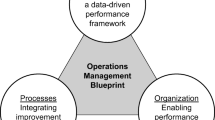Abstract
This article presents a new approach for performance measurement in organizations, integrating the analytic hierarchy process (AHP) and objective matrix (OM) with the balanced scorecard (BSC) dashboard model. This comprehensive framework prioritizes strategic objectives, establishes performance measures, and provides visual representations of progress over time. A case study illustrates the method’s effectiveness, offering a holistic view of organizational performance. The article contributes significantly to performance measurement and management, providing a practical and comprehensive assessment framework. Additionally, the project focuses on creating an intuitive dashboard for Fursa Foods Ltd. Using IoT technology, it delivers real-time insights into environmental variables affecting rice processing. The dashboard allows data storage, graphical representations, and other visualizations using Python, enhancing production oversight for the company.
Access this chapter
Tax calculation will be finalised at checkout
Purchases are for personal use only
Similar content being viewed by others
References
Liew TS, Hui WS (2015) Integrated analytical hierarchy process and objective matrix in balanced scorecard dashboard model for performance measurements. J Intell Manuf 26(5):981–991. https://doi.org/10.1007/s10845-014-0934-7
Harun NZ, Abas H, Abas NH (2015) A survey of software testing practices in Malaysia. J Softw Eng Appl 8(11):545–557. https://doi.org/10.4236/jsea.2015.811053
Babar MA, Brohi SN, Mendes E (2010) An empirical study on software testing practices and challenges in global software development. Inf Softw Technol 52(11):1191–1204. https://doi.org/10.1016/j.infsof.2010.07.004
Xia X, Yue T, Briand L, Labiche Y (2014) Exploring the relationship between test case properties and defect detection effectiveness. IEEE Trans Softw Eng 40(3):267–281. https://doi.org/10.1109/TSE.2013.22
Gorla A, Gross F, Zeller A (2012) An empirical study of the effects of test suite reduction on fault localization. IEEE Trans Softw Eng 38(2):272–290. https://doi.org/10.1109/TSE.2011.47
Rodrigues MA, Vieira M, Maldonado JC (2019) A systematic literature review of software testing in the cloud. Inf Softw Technol 108:33–53. https://doi.org/10.1016/j.infsof.2018.11.005
Shang C, Chen Y, Zhou Z (2017) Automated GUI testing using artificial intelligence. IEEE Trans Softw Eng 43(1):26–48. https://doi.org/10.1109/TSE.2016.2614957
Khanna R, Gupta RK (2016) Testing concurrent software: a systematic literature review. ACM Comput Surv 49(3) (Article 53). https://doi.org/10.1145/2884781
Goncalves MJ, Fernandes JP, Rocha HG (2018) Automated testing of Android applications: a systematic literature review. J Syst Softw 146:169–182. https://doi.org/10.1016/j.jss.2018.10.032
Hasan I, Javed MA (2019) Continuous testing in DevOps. In: 2019 IEEE 19th international conference on software quality, reliability and security companion (QRS-C)
Lind JD, Musser JD (2017) Key considerations for effective dashboard design. J AHIMA 88(1):14–19 PMID: 28125795
Mayorga R, Duchowski AT (2019) Dashboard design: the effect of emotion and perception on user experience. Int J Human Comput Interact 35(17):1567–1580. https://doi.org/10.1080/10447318.2019.1597525
Hemphill CL, Long BL (2016) Designing and implementing effective dashboards. J AHIMA 87(7):40–45 PMID: 27427633
Alshehri S, Al-Yahya M, Almutairi M, Al-Nuaim H, Almudimigh A (2020) Dashboard design: a comparative study of user perception and performance. Int J Hum Comput Interact 36(17):1613–1623. https://doi.org/10.1080/10447318.2020.1827647
Qin J, Zhou Z (2019) A survey of dashboard design guidelines. J Vis 22(1):1–15. https://doi.org/10.1007/s12650-018-0523-3
Alshammari M, Alshammari T (2018) Agile testing: an overview. J King Saud Univ Comput Inf Sci 30(3):363–370
Duvvuri S, Gargeya VB (2020) The role of artificial intelligence in software testing: a review. In: Proceedings of the 2020 4th international conference on computing and artificial intelligence (pp 128–133)
Author information
Authors and Affiliations
Corresponding author
Editor information
Editors and Affiliations
Rights and permissions
Copyright information
© 2024 The Author(s), under exclusive license to Springer Nature Singapore Pte Ltd.
About this paper
Cite this paper
Arputharaj, J.V., Yakub, M.E., Haruna, A.A., Senthil Kumar, A. (2024). Review and Design of Integrated Dashboard Model for Performance Measurements. In: Zen, H., Dasari, N.M., Latha, Y.M., Rao, S.S. (eds) Soft Computing and Signal Processing. ICSCSP 2023. Lecture Notes in Networks and Systems, vol 840. Springer, Singapore. https://doi.org/10.1007/978-981-99-8451-0_1
Download citation
DOI: https://doi.org/10.1007/978-981-99-8451-0_1
Published:
Publisher Name: Springer, Singapore
Print ISBN: 978-981-99-8450-3
Online ISBN: 978-981-99-8451-0
eBook Packages: Intelligent Technologies and RoboticsIntelligent Technologies and Robotics (R0)




